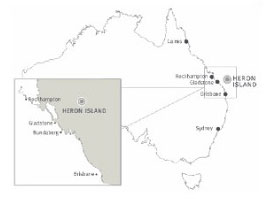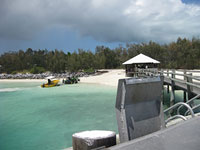

 | |||||||||||||||||||
|
|
Journals 2009/2010Jacqui Smoler
November 11, 2009 Today I awoke at 3 a.m. to prepare for my journey to Heron Island in the world famous heritage area of the Great Barrier Reef. The forecast temperature for Adelaide (my home town) was 38° Celsius and I was glad to be going to a tropical island with a comfortable daytime temperature of about 29° Celsius. The taxi cab arrived at a rather unfashionable time of 4.15 am and took my husband David and I to the Adelaide airport. David was fortunate enough to be able to take a break from work and join me on my adventure into paradise. Our journey to Queensland began with a two and half hour flight to Brisbane and then onto a connecting flight for another one and half hour north, to the bauxite mining town of Gladstone. Upon arrival in Gladstone airport our complimentary transfer bus dropped us off at the Gladstone Harbor where we were advised to take travel sickness tablets before climbing on board the catamaran to Heron Island. We were informed by the crew that it would be a rough trip for most of the two hour journey and they were right! Despite the fact we were at sea, there was still time for the "Last Post" to be played. In British Commonwealth countries, November 11th is Remembrance Day, an important day which commemorates the end of the hostilities of the Great War (World War 1). On this day the Armistice was signed which occurred on the eleventh hour of the eleventh day on the eleventh month in 1918. It is a tradition to remain silent for one minute at 11 am to remember those who died, especially the soldiers without a known grave. I could not help thinking at the time how fortunate I was to be alive and have this wonderful opportunity to visit Heron Island and learn more about the marine environment with the view of imparting this knowledge to the next generation. The Great Barrier Reef is the largest coral reef system in the world, consisting of approximately 3000 reefs and 900 islands, extending for 2600 kilometres over an area of 344,400 square kilometres. It is one of the seven natural wonders of the world, longer than the Great Wall of China and the only living thing that can be seen from space. As the catamaran pitched up and down in the beautiful choppy blue tropical waters, I knew that my adventure had truly begun. Heron Island is situated 72 km off the coast of Gladstone in Central Queensland. It consists of an 8 hectare sand cay which lies on the Tropic of Capricorn on the leeward edge of a coral reef platform. Heron Island was first occupied by a failing turtle soup cannery factory in the 1920s before the focus turned to tourism in 1936. The Great Barrier Reef Committee identified Heron Island as a specialised and unique location to establish the first permanent research station in the 1950s and such was the beginning of Heron Island Research Station (HIRS). Heron Island Research Station, Voyages Heron Island Resort and Queensland Parks and Wildlife Service (QPWS) remain the only tenants on the Island. The QPWS Office is responsible for ensuring that all activities comply with National and Marine Park regulations. Heron Island has a sub-tropical climate with average year-round temperature of approximately 24° C. It has a summer temperature range of 24° C overnight to 34° C during the day and a winter temperature range of 16.5° C overnight to 25.5° C during the day. Heron Island is famous as a primary nesting site for both Green and Loggerhead turtles and has an abundant birdlife set amongst dense stands of Pisonia sp.forest, which is home to thousands of Noddy Terns and Shearwater Mutton birds. Rail birds and Herons although less common can be seen wandering around the island but you have to look more carefully for them. David Attenborough will be visiting the island on December 11th this year.
Upon arrival at Heron Island I was greeted by Marine Biologist Dr. Julian Caley, who is in charge of the Australian node of the Census of Marine Life, which is one of fourteen in the world. Julian's research interests are primarily within the area of marine biodiversity and evolutionary ecology. Julian is the Principal Research Scientist for AIMS (Australian Institute for Marine Science), which is a branch of the Queensland University. Later in the day, Julian introduced me to several people who work at the Heron Island Marine Research Centre.
Shawn Smith, CReefs Australia Field Project Manager and my primary contact prior to arrival on the island, introduced me to Francois, a French doctorate student who is studying Echinoderms and has a particular interest in sea cucumbers. Francois showed me one specimen in a tank at the research centre which is able to shed some of its skin as a kind of offering to predators. By offering the skin, the predator's appetite is presumably satiated so that it will not attack the sea cucumber. Phil Bock is an extremely passionate, semi-retired and highly experienced biologist who studies lace corals, otherwise known as bryozoans. Phil is a youthful seventy year old who lives in Victoria and works as an honorary associate at the Melbourne Museum. He was keen to show me a website that he developed, www.bryozoa.net, which includes a taxonomic database of bryozoans that dates back to 1758, an important date in taxonomy as it coincides with the publishing of Linnaeus' book, Species Plantarum. The database is largely text-based but also includes photographs of lace corals underwater in their natural environment. Bryozoans belong to Phylum Bryozoa and tend not to be a popular choice of animal to study by younger scientists because the literature is difficult to access and are they are not easy to study. I witnessed Phil on several occasions using hand drills to cut pieces of hard coral so that he could gain access to the more delicate lace corals which grow on them. Lace corals have a three-layered body cavity consisting of an endoderm, mesoderm and ectoderm. They have a digestive cavity with two openings (ilectoprocta) in which the mouth and anus are at two opposite ends, just like mammals (sic)! Charlotte is a marine worm biologist who has a particular interest in the Sepulidae family of Phylum Polychaeta. She showed me a rather spectacular specimen, Spirobranchus corniculatus which had a bright red radiolar fan which the worm uses to breathe. By waving the radiolar fan around in the water it is also able to waft food particles to its mouth which is located at the end the worm near the fan. Waste material is then excreted through the anus located near the mouth. I found this most unusual and asked Charlotte for more details. Since the worm lives in a calcareous tube it has a U-shaped gut which explains the curious positioning of the mouth and nearby anus. An operculum is located above the mouth and anus which is able to open and close. The worm has feet-like structures called setae attached to the outer surface. The thoracic part of the organism is orange and extends about 1 cm along the length of the worm which is about 4-5cm long.
Finally, I was introduced to Abby, a young, American geneticist who collects samples of tissue from all of the other biologists for DNA bar-coding. I did not know at this stage that I would be spending a lot of time over the next few days snorkeling with Abby and discovering more about her work. |
||||||||||||||||||




